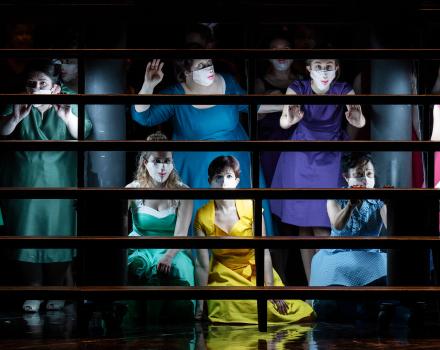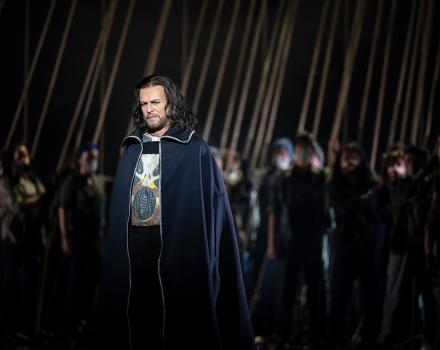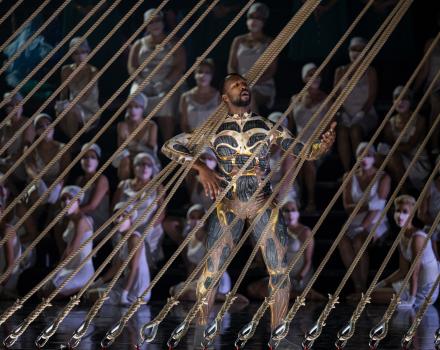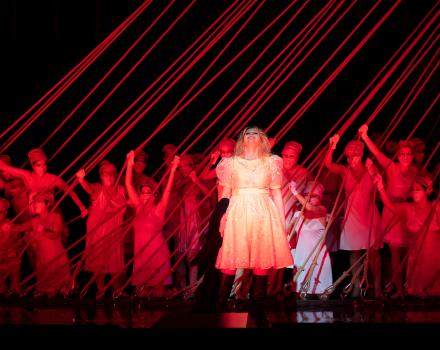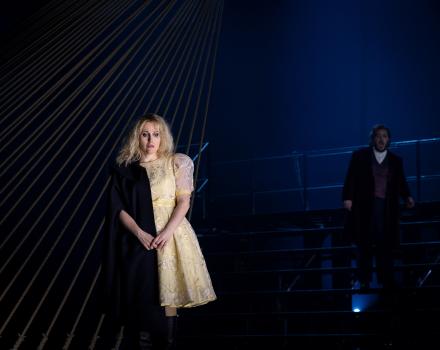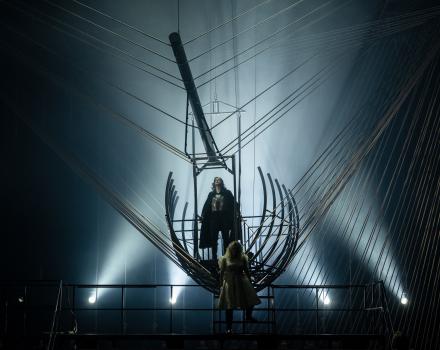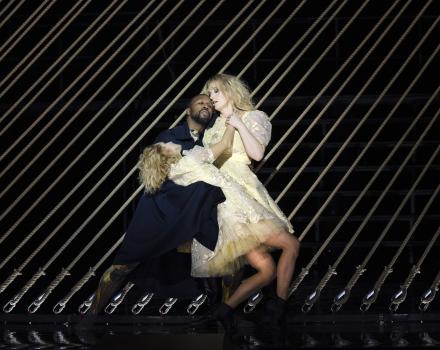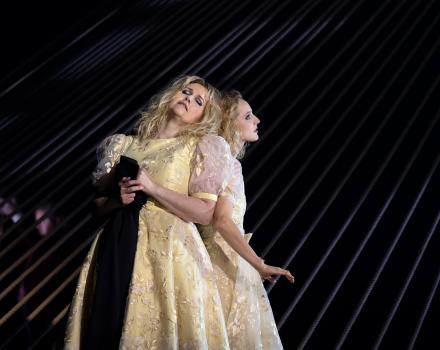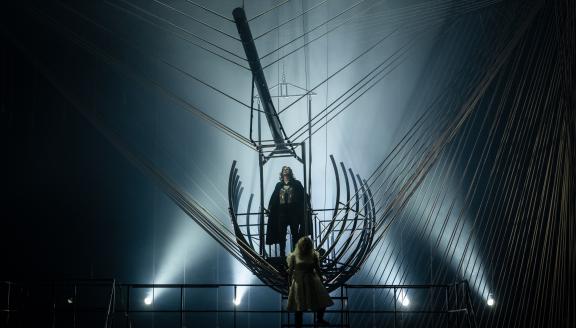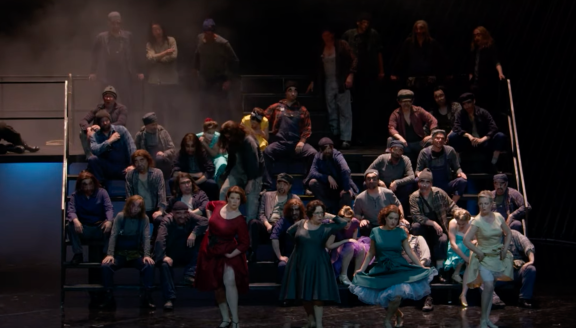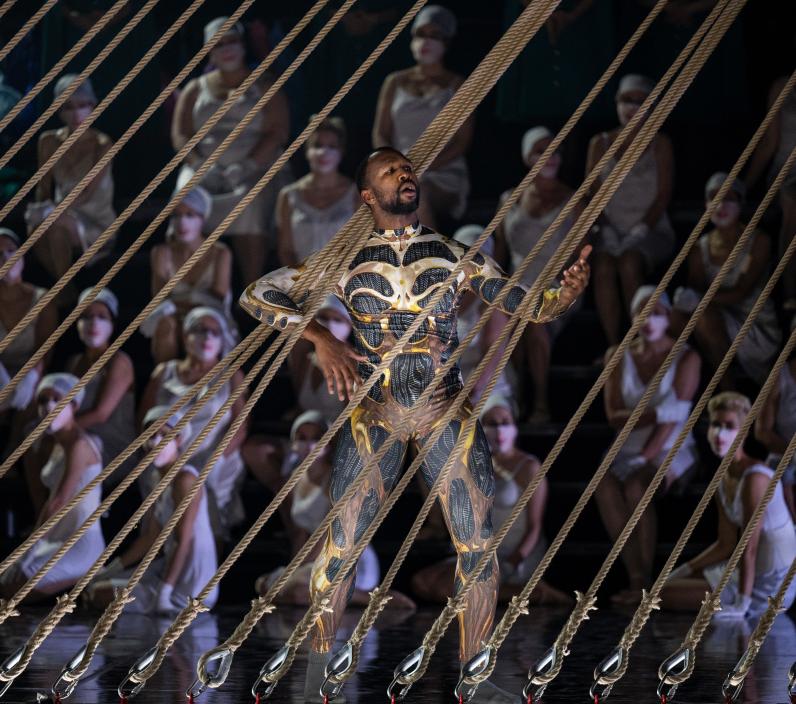

A captain is cursed to sail the seas of the world forever, only allowed to make landfall once every seven years. Will he find the love of a faithful woman to break the curse?
Richard Wagner came across the legend of The Flying Dutchman in 1838 through Heinrich Heine’s From the Memoirs of Herr von Schnabelewopski. After a stormy voyage from Riga to London – Wagner was again on the run from creditors – he chose the material for his next opera and began to compose it, with the unpredictable power of the sea still fresh on his face. Against the backdrop of this wild nature, Wagner exposes in Holländer his utopia of a love that transcends, offered as an antidote to the 19th century zeitgeist of pounding industrialisation and economic growth. Roger Vontobel’s new production from Mannheim is streamed live on the opening night and audiences around the world can share in some of the most rousing music written in opera.
Cast
|
Daland
|
Sung Ha
|
|---|---|
|
Senta
|
Daniela Köhler
|
|
Erik
|
Jonathan Stoughton
|
|
Mary
|
Marie-Belle Sandis
|
|
Steersman
|
Juraj Hollý
|
|
The Dutchman
|
Michael Kupfer-Radecky
|
|
Dream Senta
|
Delphina Parenti
|
|
Dream Dutchman
|
Michael Bronczkowski
|
|
Chorus
|
Opernchor des Nationaltheaters Mannheim
|
|
Orchestra
|
Nationaltheater-Orchester
|
| ... | |
|
Music
|
Richard Wagner
|
|---|---|
|
Text
|
Richard Wagner
|
|
Conductor
|
Jordan de Souza
|
|
Director
|
Roger Vontobel
|
|
Sets
|
Fabian Wendling
|
|
Lighting
|
Florian Arnholdt
|
|
Costumes
|
Ellen Hofmann
|
|
Chorus master
|
Dani Juris
|
| ... | |
Video
The story
Act I
A storm has driven the sea captain Daland's ship ashore. The voyage has exhausted the crew and soon they all go to rest. The Steersman tries to keep up his spirits with a song but falls asleep on the watch. Suddenly a strange vessel pulls alongside Daland's ship. Its captain is the Flying Dutchman, who has been condemned to eternal wandering unimpeded by storms or pirates. Once in seven years he is permitted to land. The Dutchman offers Daland unheard-of wealth, pleading in return for lodging and the hand of his daughter, Senta. Daland accepts the Dutchman's proposal, and the ships set sail.
Act II
Waiting for the return of Daland's ship, the girls are working on their spinning wheels and singing. Senta's friends tease her about the huntsman Erik, her ardent suitor. Senta, heedless of facetious remarks, sings a ballad about the Flying Dutchman, which she came to love already in childhood, and discloses her innermost secret: with a faithful love she wishes to save the harried seaman. Senta's words surprise Erik, who is overtaken by a strange foreboding. He relates a dream in which he saw her embrace the mysterious captain. The Dutchman and Senta's father appear, and the father announces the marriage arrangement. Senta is transfixed by the Dutchman. The Dutchman does not turn his eyes from Senta, hoping that her love and faithfulness will lift his curse.
Act III
Sailors celebrate their safe return to land. They call out to the Dutchman's ship, inviting the crew to join them, but the ship remains dark and silent. Daland's sailors deride the mysterious crew and their captain. A storm rises and apparitions approach the shore over the waves, and with that the invited guests have arrived.
Erik tries to dissuade Senta from binding her life with the eerie stranger. Senta is unwilling to listen to him, for she has made an oath and is called by a supreme mission. Erik then reminds her of his love for her. The Dutchman, seeing Senta together with Erik, is stricken by desperate jealousy and a sense of loss, believing that Senta, too, has failed to render him undying faithfulness. He reveals his secret and sets off towards his ship to continue this endless roaming prescribed by the curse. Senta throws herself into the sea from the top of a cliff thus redeeming the Dutchman's sins with her death. The Flying Dutchman's ship disintegrates against the cliffs, and his odyssey comes to an end.
Insights
Was it all a dream?
Dramaturg Marion Tiedtke interviews the director Roger Vontobel, set designer Fabian Wendling, costume designer Ellen Hoffmann, choreographer Zenta Haerter and video artist Stefan Bischoff.
Marion Tiedtke: During our preparations, we constantly asked ourselves: How can we interpret this opera, which is almost 180 years old and has been performed countless times, for modern times?
Roger Vontobel: My approach to these old stories always relates to a particular and deliberate way of storytelling – a kind of gateway to interpreting the opera. Very early on, Wagner was very critical of the development of capitalism – not dissimilar to the way we view the climate change catastrophe today: we too want to break out of an environment that oppresses and makes us ill, but in our powerlessness, we tend to escape into a substitute or illusory world to distract ourselves. Senta's story is an escape from a patriarchal and capitalist world where there are no values other than material ones. She longs for a greater purpose, for happiness of a different kind. She loses herself in this longing, numbs herself with daydreams that point to a schizophrenic, ultimately lethal state of mind from which there seems to be no escape.
MT: How did you come up with the idea of ropes in the set and what do they portray?
Fabian Wendling: The set design is based on the spinning mill at the beginning of the second act, which we decided to use as the starting point for our interpretation. We maintained the idea of the spun threads, but chose the rougher variant of rope, which can equally symbolise the rugged working world of the men at sea and the rough factory world of the women in the spinning mill. Senta’s everyday life takes place in this mill, from which she wants to escape with the Dutchman, so it made sense to depict her dreams and longings as distortions of this setting. In the end, the rope becomes the cord with which the women tie their bodices and with which Senta ultimately kills herself. In the opening scene, 53 rope winches form a kind of prison and a raised platform serves as a surveillance post for the guards
MT: Since Senta’s ballad was Wagner‘s starting point for the composition, we decided to interpret the opera from Senta’s point of view: we find ourselves in a world in which dreams and reality intertwine. This allows for a new freedom with the costumes, which often appear as quotations of contemporary culture. What were your main inspirations?
Ellen Hofmann: For me, The Flying Dutchman is a horror tale that could just as easily take place in a dystopian novel from the eighties as in a modern Hollywood film by Quentin Tarantino. When we talked as a team about the group of spinning girls in the second act, we often talked about Margaret Atwood's novel The Handmaid’s Tale and the series that came out of it. They are basically forced labourers in Daland's house, making their own corsets and dresses to please the arriving sailors. They are 'groomed' for the marriage market in order to be 'presented to the man' in the best possible way. In our production, these are costumes in the style of the fifties, when the women still dressed in a very feminine way. Senta's governess Mary is based on Aunt Lydia in Atwood's novel: a guardian who on the one hand enjoys the confidence of her girls, but on the other hand punishes and tortures them so that no one dares break out of the system. The costume for Daland is inspired by Leonardo Di Caprio as Calvin Candie in Django Unchained.
MT: What stylistic dance techniques do you use in your work and how do you develop your choreography with them?
Zenta Haerter: I am influenced by classical and modern dance, but over the years, I have developed my own choreographic language. For some time now, I have been working mainly with dancers who are familiar with new dance techniques that I did not learn in my training. I find it enriching to be able to benefit from dance techniques that are unknown to me and I select my dancers accordingly. However, they have to know my basics so that we have a common starting point. I use a mixture of improvisation and choreographic elements. Specifically in this opera, we combine classical ballet language with moments of dreaming, longing, beauty, lightness - the dream of redemption, which other modern dance techniques deliberately counteract.
MT: In the overture, which unites all the musical elements of the opera and has often been called a 'Meeressinfony' (sea symphony), the audience experiences a cinematic journey through Senta's eye into the world of her soul, which ultimately leads us into the first act. What visual associations and techniques were important to you in the creation of the dream journey into Senta's mind?
Stefan Bischoff: With the video we created an opening to the opera where dream and nightmare motifs intertwine in Senta's head. In other words, I worked with the film technique of collage. We filmed with the singer and added footage from the ocean depths, fjord landscapes and a journey to the place where the story begins. It feels like a rush, a trip, before Senta takes her own life. At the end, everything rewinds back at a hurtling pace. We are familiar with these techniques from cinema films, for example. They allow us to combine several planes: reality and dream, time and space.
Gallery
